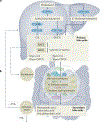Bile acids and the gut microbiota: metabolic interactions and impacts on disease
- PMID: 36253479
- PMCID: PMC12536349
- DOI: 10.1038/s41579-022-00805-x
Bile acids and the gut microbiota: metabolic interactions and impacts on disease
Abstract
Despite decades of bile acid research, diverse biological roles for bile acids have been discovered recently due to developments in understanding the human microbiota. As additional bacterial enzymes are characterized, and the tools used for identifying new bile acids become increasingly more sensitive, the repertoire of bile acids metabolized and/or synthesized by bacteria continues to grow. Additionally, bile acids impact microbiome community structure and function. In this Review, we highlight how the bile acid pool is manipulated by the gut microbiota, how it is dependent on the metabolic capacity of the bacterial community and how external factors, such as antibiotics and diet, shape bile acid composition. It is increasingly important to understand how bile acid signalling networks are affected in distinct organs where the bile acid composition differs, and how these networks impact infectious, metabolic and neoplastic diseases. These advances have enabled the development of therapeutics that target imbalances in microbiota-associated bile acid profiles.
© 2022. Springer Nature Limited.
Conflict of interest statement
Competing interests
The authors declare no competing interests.
Figures




References
Publication types
MeSH terms
Substances
Grants and funding
LinkOut - more resources
Full Text Sources
Other Literature Sources
Research Materials

